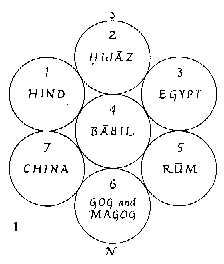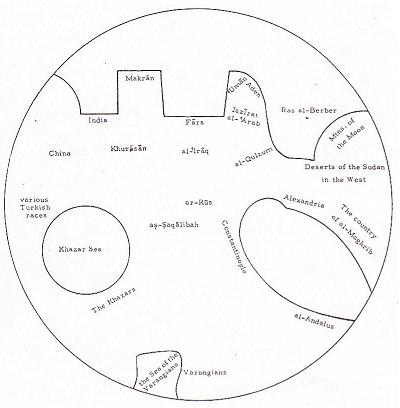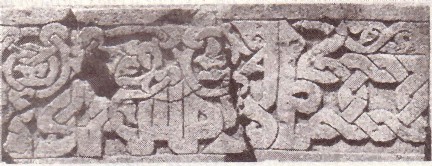
To next page
Yakut (or Jakut) al Hamawi (1220) Kitab Mu'jam al-buldan (geographical directory)
a Greek slave born in Aleppo
------------------------------------------------------
Yakut's view on the world as he copied it from Al Biruni.
Taken from : Jwaideh, Wadie ; The introductory chapters of Yakut's....
East Africa he situates in the first clime (Hind) In it he inscribes:
The first clime is that of India. Its limits are the Sind and the Sea in those parts of it that lie in the East, extending to Daybul of the land of the Sind and the islands that are named after it, namely, the Dibajat, the Zabay and the Zenj. The end of its limits (in the west) is Makran, which stretches to the confines of al-Basrah between India and the Yemen. Its sign is Capricorn; the Lord of its hour is Saturn when the moon is in Aquarius.


A coral stone inscription of 1107 AD is carved in Kufic writings and inserted into the left block of the mihrab of the mosque of Kizimkazi (rural Zanzibar). Dedicated to Sheikh Abu Mussa El Hassan Bin Mohamed who built the Mosque. It reads: "Sheikh Said Abi Amran Mfaume Al Hassan Bin Mohammad. May God grant him long life and destroy his enemy. Ordered the building of this Mosque, in the Day of Sunday, in the Month of Dhul Kaadi, in the Year of 500 H".
The rest of the mosque is from a later date; mostly 19th century
commerce...
Neville Chittick; East Africa and the Orient.
Marcel Devic; Le pays des Zendjs
Jwaideh Wadie; The introductory chapters of Yakut...
Gabriel Ferrand; Relations des voyages et textes geographiques....
Gabriel Ferrand; Les Comalies
Youssuf Kamal Tome III Fasc 5
His geographical directory is an alphabetical dictionary in V volumes, every city is a different entry. For quite a number of entries I was unable to find the exact location so they appear in random sequence.
As for the extension of the Western Encircling Sea, from the land of Tanjah southwards, it swerves towards the south along the lands of the Western Sudan, beyond the mountains known as the Mountains of the Moon, from which spring the sources of Egypt's Nile. Its navigation is fraught with peril, from which no ship escapes.
The other Gulf mentioned above is the one known as the Sea of the Berbers, which stretches from Aden to Sufalah of the Zanj, beyond which no ship ventures because of the great risks involved.
The land of the Zendj starts from the Sea with that name, and extends to the south under Canope. And is in any case situated on the other side of the equator because the people see the South pole nearly in the middle of the sky, but do not see nor the north pole, nor the goat (al djedi) nor the big bear.
We already mentioned that the beginning of the Persian Sea is Tiz, this when going to the north. Because when going to the south one will find the land of Zandj.
In the Sea of Berber one finds in the east, first the islands of Zanedj, then the Dibadjat, then Qomair, and last the islands of the Zendjs.
(I p501)The sea of Berbera: it stretches from Aden till Sofalat ez-Zeng
The lands of the Zeng: are in the south, under Canopus, there is the continent and there are many islands, big and wide, with a lot of wood and trees, but they are not fruit trees, but ebony, teak, and others, amber is collected on its beaches, and it is only here that you find it. And the people live here poorly, and somebody has told me, somebody who had gone to these countries himself, that one sees the polestar of the south in the middle of the sky just as Canopus, and one does not see the stone-buck, the regular polestar and never the northern constellation of the bear.
The Zendjs see in the sky something of the same size as the moon, it resembles a round window (taqa) in the sky where there is a small white cloud that never dissolves or goes on. I (Yakut) have interrogated many people about that and all answered the same. The Zendjs give it a name which I do not remember, and they do not know what it is.
Cities are found on Bahr az-Zanj (He is the first to use the word Zandj-bar), the most important being Maqdishu. Their inhabitants are foreigners (ghuraba) who settled on that region. They are Muslims, tribal sections, having no sultan but each clan having a shaikh whose orders they carry out. It (Mogadishu) is situated on the mainland of the Barbar who are a tribe of nomads (urban) not those whose country is the Maghrib, (but intermediary) between the Habasha and the Zunuj.
Then the country of Berbera stretches up to Zeng and the sea goes up to Aden, and this sea stretches further, till it reaches the Ocean.
(Ip503)Bahr al Qoulzoum; this is also a branch of the sea of India; it starts close to the land of the Barbar and the Sudan of which we talk when mentioning the Sea of the Zandj and Aden...
(Ip504)Al Bahr al Mouhit (the encircling Sea). This is the sea from which all seas off which we talk spring�.Two branches come out of it�. The eastern one is the sea of Hind of Sin and Faris of alYaman and of al Zanj
(Ip543-544)Berbera: Is a town situated between Abyssinia, the land of the Zendjs and Yemen. The people are very black and speak a language that only they can understand. They are nomadic and eat wild animals. In their country you find strange animals only found there, among them; the giraffe, the leopard, the rhino, the panther, elephant, ... The people of Berbera practice emasculation, which is mentioned in the article on Zeila. El-Hasan ben Ahmed ben Yaqoub el Hamadani of Yemen tells the following: among the islands close to the shore of Yemen is that of Berbera. at the end of the shore of Abyan. It is in the sea towards Aden, on the side where Canopy appears on the western side, you have in front of you the mountain of smoke, that is Soqoutara. About the description of their hunting. Several of the people who penetrated their country (of Zendj) say that those people have a kind of plant mauve from color, they boil it and take out the juice. That is boiled till it becomes like resin. To check if it is very poisonous, somebody makes himself a small wound, and when the blood starts running, they bring the poison close, on the point of a knife, if the poison is strong, the blood will get back into the wound. The man has to stop it because it might bring some of the poison into the wound, what will kill him. If the blood does not go back into the wound, they have to make new poison. The poison once prepared is put in a small box put on the belt. They sit in ambush in the trees, and when they see a wild animal, the hunter puts a little bit on top of his arrows. If the poison mixes with the blood, every animal dies, the people then go and take the skin, the horns or the ivory and sell them. One can eat the meat, it does not hurt. This is the land that they call Souah'il Berbera.
(Ip861)Takrur, with two undotted r's. A country named after a tribe of the Sudan in the furthest south of the Maghrib. Its people most resemble the Zunuj.
(II p75/6) Jaziiratul Khadhraa(Jazirat al-Khadra) the green island (pemba) is also a large island in the land of the Zenj in the Indian ocean. It is long and wide. Salt water is surrounding it on every side. In it are two towns. One is called Mtambwe Kuu, (now Matumbini) and the name of the other is Mkanbalu (now Ras Mkumbuu). In each of the towns is a sultan (mfalme) of its own. Each of the towns has its own independence. There are also other villages and markets. Its sultan says he is an arab, and that he has come to stay there from Al-Kufa (in Iraq). I have been told this by Sheikh Salim Abdel Malik Al Halawi who came from Basra. He saw this with his own eyes, and knows it. He is a reliable man.
(II p966-967)Zeila.....(when talking about Zeila)....Le Cheikh Ouelid el Bacri, who had traveled in many countries, told me the following. Berber is the name of a tribe of Negroes, between the land of the Zendjs and Abyssinia. They have a strange custom, even though they attach their genealogy to El-Akta, and they are reckoned among his family. They live in the desert in huts made of dried grass. If one among them loves a women and wants to marry her, and she is socially not of the same standing as he, he will take among the cows of the father of the women, a cow close to give bird, cuts the hair of the tail and lets her go. Then he himself flies looking for someone he can emasculate. When the one who was herding the cattle comes back and tells the story to the father of the women, or to someone of the relatives who have to look after her, they go and chase him. If they catch him, they kill him. If not he continues till he meets someone that he castrates and he brings the trophy. But if the cow has delivered the calve before that, he has missed his chance. He never comes back to his tribe and lives in places where he is unknown, because if he returns home he is killed. If he reaches his goal however, he becomes the owner of the girl without anybody being able to stop him, whoever the women might be...
(III p97/8) Sofala is the most remote known city (medina) in the country of the Zenj... wares are carried to them, and left by the merchants who go away, and coming again find that the natives have laid down the price for every article besides it ...Sofala gold is well known among the Zenj merchants.
(IIIp101-102)Soqotra, big island with several towns and villages close to which you pass to go to the Zendjs. One finds there aloes and dragon-blood, which is the gum of a tree that you won't find anywhere else... The sailor who goes from Aden to the land of the Zendjs keeps its road like he is going to Oman having Soqotra on the right, till he has passed it. Then he turns to the sea of the Zendjs and passes the island at a distance of 24 parasanges
(IIIp308)Chouqar (or Suqar)�.;Chouqar is also a locality that belongs to the Zandj and from which a big amount of slaves is exported these are those, whose lower brows consist of two or three lines.
G. Rotter gives two possibilities for for Suqar; Shaka on the coast north of the Tana or the tribe of the Sagara west of Dar-es-Salaam.
(IV p174)Al-Kumr is an island in the middle of the sea of the Zandj which contains many villages no island is larger then it. It comprises a large number of towns and kingdoms. Each king makes war on the other. On the shores are found amber and the leaf al-Kumari. This is a perfume, it is also called betel leaf. Wax (sama) is also obtained from it.
(IV p302)Kilwa, a town in the country of the Zanj. (he is the first to identify Kilwa)
(IV p366) Leikhouna, (or Bandjouya or Lendjouya (Unguja), Landschuja) is a big island and the seat of the elected kings in the land of the Zendj where the king lives. Ships from all countries come there for careening and repair. People of the island of Tumbat were Muslim and the people of Lenguja have been forced to flee to Tumbat to escape from their enemies. You find their vines that have fruit three times a year. Each time when a fruit is ripe another one is being formed.
(IV p485)
Baouari and Moulenda, two towns in the neighborhood of the Zendjs from which amber is exported.
Djoubb (El Jub), town in the neighborhood of the county of the Zendj, on the land of Berbera from where one exports giraffe skins which serve in Persia to make shoes.
(IV p502)Merca is a town on the coast of the Zanj (Zandschabar), belonging to the Berbers of the Blacks, not the Berbers of the Maghrib.
(IV p602)Maqdishu is a city at the beginning of the country of the Zanj to the south of Yemen on the mainland of the Barbar in the midst of their country. These Barbar are not Barbar who live in the Maghrib for these are blacks resembling the Zunuj, a type intermediary between the Habash and the Zunuj. It is a city on the seacoast. Its inhabitants are all foreigners (ghuraba), not blacks. They have no king but their affairs are regulated by elders (mutaqaddimun) (mouteqaddamoum) (m'kaddem) according to their customs. When a merchant goes to them he must stay with one of them who will sponsor him in his dealings. From there is exported sandalwood, ebony, ambergris, and ivory - these forming the bulk of their merchandise - which they exchange for other kinds of imports.
(IV p656)Menbaca; big town in the land of the Zendjs where the boats anchor.
(IV p762)Nujah (or Nudschah) (Naja of Idris) a town of the land of the Berbers of the Zanj (Barbarat az Zanj), on the shores of the ocean, after a town called Markah, and Markah is after Maqdishu on the sea of the Zanj.
(IVp861-864)Al Nil; Its originates in the land of the Zandj and it goes through the land of the Habasha parallel with the coast of the sea of al Yaman on the side of the land of Habacha�.
Waqwaq is (merely) part of the fabulous hold the sea has on Sailors' and storytellers' imagination.
About the equator that is used as a base for the astronomers. Al Biruni says that the equator starts on the eastern side, in the south of the sea of China and India, that it passes by certain islands that are in that sea, till it passes the islands of Zabag, where lots of gold is found. then it passes by the island of Kaleh which is a harbor midway between Oman and China, it passes by the island de Sribuza which is situated in the east of the green sea. It passes all along the southern part of the island of Sirandib, the islands of Dibajat and it passes in the north of the country of the Zanj and to the north of the mountains of the Moon.
Az-Zabag� This is an island in the area east of India, behind the sea of Herkand, in the area of China. It is said that this island belongs to the Zanj�.
(Dictionary of learned men)
-------------------------------------------------
Taken from: Journal of the Royal Asiatic Society of Great Britain and Ireland 1914
Also called: Mujam ul Udaba
The grammarian Mubarak b. Mubarak al-Wajih, was a teacher of Yakut and a man distinguished by wide linguistic attainments; Arabic, Persian; Turkish; Greek; Ethiopic; Armenian; Zanjiya and another pupil of him was Abd al-Latif al-Baghdadi.
In Arabic the vowels are mostly not written down, so the writing of the two towns is:
MTNBJ and MKNBLU. Two explanations are given for these names: one is
Metenebi and Mekenebulu. The second name resembles strongly Al Masudi's Kanbalu.
Another scientist came up with another explanation:
Matumbi(ni) and Mkumbuu. The first is an island, which is shown on the map of Yakut and lies on the south west of the modern town of Mkoani on the main land of Pemba. The ruins of Mkumbuu lie at the extreme point at the head of a long and narrow peninsula on the west coast of Pemba. (archeological search of these ruins did not give sufficient prove as to the dating of the ruins)